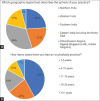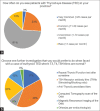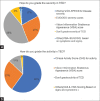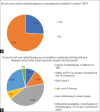Thyroid eye disease survey: An anonymous web-based survey in the Indian subcontinent
- PMID: 32709788
- PMCID: PMC7640870
- DOI: 10.4103/ijo.IJO_1918_19
Thyroid eye disease survey: An anonymous web-based survey in the Indian subcontinent
Abstract
Purpose: To evaluate the current practice patterns in the treatment of thyroid eye disease (TED) in Indian subcontinent through a web-based survey of members of Oculoplastics Association of India (OPAI).
Methods: This was an online web-based questionnaire survey disseminated via monkeysurvey.com to all ratified active members of OPAI between May 1, 2016 and June 30, 2016. Questions encompassed the background, training, region, and experience of oculoplastic surgeons along with the management protocol of TED.
Results: Of the 435 emails sent to OPAI members, 9 bounced and 180 (42.3%) responded within the study period. A large majority (96%) of respondents were oculoplastic surgeons practicing in India and the remaining practiced within South-East Asia. Two-thirds of respondents were oculoplastic surgeons with less than 10 years of clinical experience; 82% were fellowship trained in Oculoplasty. Almost all (99%) favored a multidisciplinary management of TED. A large majority routinely grade the severity (89%) and activity (87%) of disease before management. While corticosteroid remained the treatment of choice, 54% preferred immune-modulators as the second-line of therapy for recalcitrant TED. Three-quarters did not use orbital radiotherapy as a management modality in active TED owing to concerns over its efficacy and/or safety.
Conclusion: The survey gives useful insights to the practice patterns of TED management in Indian subcontinent. Multidisciplinary approach and grading of disease severity and activity were the rule rather than exception among OPAI members. Immune modulation was the preferred steroid-sparing agent in recalcitrant disease. Orbital radiotherapy was an uncommon treatment choice.
Keywords: India; orbital decompression; survey; thyroid eye disease.
Conflict of interest statement
None
Figures




Comment in
-
Commentary: Thyroid eye disease in India: A wake-up call?Indian J Ophthalmol. 2020 Aug;68(8):1614-1615. doi: 10.4103/ijo.IJO_546_20. Indian J Ophthalmol. 2020. PMID: 32709789 Free PMC article. No abstract available.
-
Commentary: Multidisciplinary team approach to tackle thyroid eye disease.Indian J Ophthalmol. 2020 Aug;68(8):1615-1616. doi: 10.4103/ijo.IJO_2202_20. Indian J Ophthalmol. 2020. PMID: 32709790 Free PMC article. No abstract available.
Similar articles
-
A Chinese survey of clinical practice on the management of thyroid eye disease.Eur Thyroid J. 2024 May 23;13(3):e230269. doi: 10.1530/ETJ-23-0269. Print 2024 Jun 1. Eur Thyroid J. 2024. PMID: 38642583 Free PMC article.
-
Treatment of severe thyroid eye disease: a survey of the American Society of Ophthalmic Plastic and Reconstructive Surgery (ASOPRS).Ophthalmic Plast Reconstr Surg. 2015 Mar-Apr;31(2):127-31. doi: 10.1097/IOP.0000000000000216. Ophthalmic Plast Reconstr Surg. 2015. PMID: 24988501
-
A Survey on the Management of Thyroid Eye Disease Among American and European Thyroid Association Members.Thyroid. 2022 Dec;32(12):1535-1546. doi: 10.1089/thy.2022.0172. Epub 2022 Sep 12. Thyroid. 2022. PMID: 35946071
-
Update on Graves disease: advances in treatment of mild, moderate and severe thyroid eye disease.Curr Opin Ophthalmol. 2017 Sep;28(5):505-513. doi: 10.1097/ICU.0000000000000402. Curr Opin Ophthalmol. 2017. PMID: 28700384 Review.
-
Advances in the management of thyroid eye diseases: An overview.Int Ophthalmol. 2018 Oct;38(5):2247-2255. doi: 10.1007/s10792-017-0694-0. Epub 2017 Aug 18. Int Ophthalmol. 2018. PMID: 28822031 Review.
Cited by
-
Commentary: Thyroid eye disease in India: A wake-up call?Indian J Ophthalmol. 2020 Aug;68(8):1614-1615. doi: 10.4103/ijo.IJO_546_20. Indian J Ophthalmol. 2020. PMID: 32709789 Free PMC article. No abstract available.
-
A Chinese survey of clinical practice on the management of thyroid eye disease.Eur Thyroid J. 2024 May 23;13(3):e230269. doi: 10.1530/ETJ-23-0269. Print 2024 Jun 1. Eur Thyroid J. 2024. PMID: 38642583 Free PMC article.
-
The burden of illness in thyroid eye disease: current state of the evidence.Front Ophthalmol (Lausanne). 2025 Apr 17;5:1565762. doi: 10.3389/fopht.2025.1565762. eCollection 2025. Front Ophthalmol (Lausanne). 2025. PMID: 40370423 Free PMC article. Review.
-
Medical management of thyroid eye disease - A paradigm shift.Indian J Ophthalmol. 2020 Aug;68(8):1515-1518. doi: 10.4103/ijo.IJO_2386_20. Indian J Ophthalmol. 2020. PMID: 32709765 Free PMC article. No abstract available.
-
Commentary: Multidisciplinary team approach to tackle thyroid eye disease.Indian J Ophthalmol. 2020 Aug;68(8):1615-1616. doi: 10.4103/ijo.IJO_2202_20. Indian J Ophthalmol. 2020. PMID: 32709790 Free PMC article. No abstract available.
References
-
- Smith TJ, Hoa N. Immunoglobulins from patients with Graves' disease induce hyaluronan synthesis in their orbital fibroblasts through the self-antigen, insulin-like growth factor-I receptor. J Clin Endocrinol Metab. 2004;89:5076–80. - PubMed
-
- Bahn RS, Heufelder AE. Pathogenesis of Graves' ophthalmopathy. N Engl J Med. 1993;329:1468–75. - PubMed
-
- Bradley EA, Gower EW, Bradley DJ, Meyer DR, Cahill KV, Custer PL, et al. Orbital radiation for graves ophthalmopathy: A report by the American Academy of Ophthalmology. Ophthalmology. 2008;115:398–409. - PubMed
MeSH terms
LinkOut - more resources
Full Text Sources

